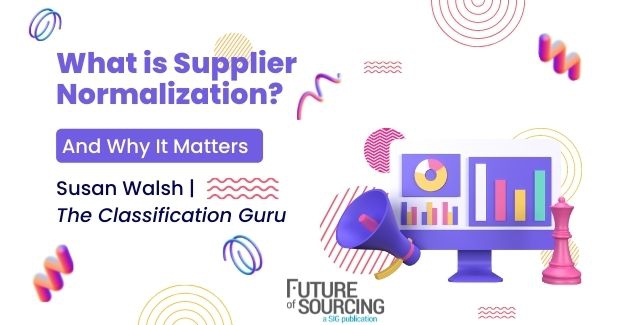Keeping your supplier information data up to date and accurate is essential to making informed business decisions says Susan Walsh, aka The Classification Guru. She provides an overview of the data classification process and the rationale to prioritize it so you don't leave money on the table.
Supplier normalization can also be referred to as standardization. Normalization is giving your existing suppliers a common name or grouping so that you can see how much you are truly spending with them or selling to them.
Sounds silly though, right?
Surely companies must know how much they are spending, selling or using with their suppliers already? You might think that, but there are a number of reasons that you might find multiple versions of the same supplier in a database.
One is that you have a global presence and each country has named their supplier as it is known in that locality. Quite often there are suffixes attached to companies such as Inc., Ltd, Limited, etc., that cause multiple versions of the same supplier.
Or you could have independent divisions of one company that all have their own naming conventions. I’ve even seen typos and incorrect spellings, and that is also how duplicate accounts get created.
Why Does Supplier Normalization Matter?
Ultimately you could be making bad business decisions if you don’t have all the correct information. If you are in procurement, you might have local arrangements with the supplier, and the price you pay for the same item could vary hugely across regions, allowing you the opportunity to negotiate a better, global pricing agreement.
Likewise, if you want to look at customer sales globally, you want to make sure you have the right information. You might think you are selling X amount to Customer A, but in fact, with normalization, you could find it’s a lot more than that. And it could affect rebates, commission, sales forecasts, marketing plans and production planning. It has a knock-on effect.
And with that knowledge are you treating that customer fairly with the appropriate discounts and customer service? Can you afford to lose this customer, or is there the opportunity to upsell to them? You can’t make any of these decisions without the right information.
And again, for procurement, there could be a target to rationalize the number of suppliers that you have agreements with. Supplier normalization is an exceptionally efficient way of doing this – I say it’s like eating chocolate without the calories.
Normalization is the First Step in Getting a C.O.A.T. for Your Data
With a spreadsheet of spend transactions over a period of time, such as 12 to 24 months, the first step should be supplier normalization. This is where a new column is added to consolidate several versions of the same company to get a true picture of spend with that supplier. For example, I.B.M, IBM Ltd and I.B.M. would all be normalized to IBM.
Data can be classified using minimum information, such as supplier name, invoice/PO line description and value. To get more from the data, other factors can then be added in, such as unit price. Where unit price information is not available, the quantity can be divided by the overall value.
A suitable taxonomy will then need to be found to classify the data. It can be an off-the-shelf product such as ProClass, UNSPSC, PROC-HE or a taxonomy can be customized so that it is specific to your organization or industry.
This initial stage may take months if you are working with large volumes of data. It might be worth outsourcing this initial task to professionals experienced in this area who can complete the project in a shorter time, with greater accuracy.
It Saves You Money in the Long Run
Data accuracy is an investment, not a cost. Addressing the issues at the beginning might seem like a costly exercise, but you will undoubtedly spend less than if you have a to resolve an issue further down the line with a time-consuming and costly data clean-up operation. And by involving the whole team or organization, it will be much easier to manage and maintain the most accurate data possible.
Spend data classification shows you the whole picture, but only if it’s accurate. You can get a true view of your spend, which allows for improved cost savings, better contract compliance and – possibly the most important – preventing costly mistakes before they happen.









